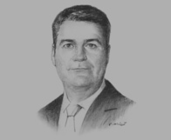OBG talks to Charles Ireland, Group Managing Director & CEO, East African Breweries

Interview: Charles Ireland
What can be done to ease the strain on manufacturers exporting within the region?
CHARLES IRELAND: The East African Community (EAC) aims to operate as a single market entity with free movement of both raw materials and finished products in the region. The reality is that this is not yet happening and there is work to be done by the various governments across the EAC to ensure we make progress in this regard. This will include working groups that define the products and categories, as well as the different tax rates, to harmonise the environment so free movement is a more realistic prospect. Digitisation and simplification of the administrative processes from one country to another will help greatly. This is all currently far more cumbersome than it would be for manufacturers in Europe.
It is necessary for the governments of East Africa to fully commit to improving the ease of doing business. What I would like to see is much more connectivity between the stated intent of governments and their actions on the ground. There is currently a real lack of implementation. China builds hundreds of kilometres of railway a year and we still haven’t even begun the planned Standard Gauge Railway.
The prospects for the region are still extremely positive, and I continue to say as much to our investors. I see this country going through 30 years of 5-10% GDP growth. However, this is not a birthright; goals need to be translated into concrete action.
From a tax and fiscal perspective, what challenges exist for Kenyan manufacturers?
IRELAND: The basic structure of the tax environment here in Kenya is quite modern. We have value-added tax (VAT), corporate tax and personal income tax. That being said, it is not necessarily competitive from an international point of view. One of the things we have to think about as a multinational corporation is where the best place is for different operations so that we are able to achieve maximum revenue.
The biggest challenge in any emerging market is the predictability of tax. There are countries in the EAC that have value indexing of tax rates, but Kenya does not yet have that. While we are not voting for indexation, I would like to see more predictability. The excise tax application on our Senator product is a case in point. We built up infrastructure to support a product and we made some very significant capital investments to service that level of volume. Then the tax came and our volumes have subsequently dropped rather significantly.
How cost competitive is Kenya currently, and how much scope is there for cutting overhead?
IRELAND: It is possible to be world class in terms of production costs in Kenya, but in order to get there you have to make some significant investments.
That being said, there are downsides to being located in Kenya. The cost of moving raw materials around and into the region is quite significant. It costs about twice as much to move a container of product 1000 km in East Africa than it does in China. In addition to this, the costs of utilities are higher than elsewhere in the world and reliability is a major issue. For instance, we have had to invest in backup generators that similar production facilities would not even have to consider.
One of the decisions we have made is not to be highly automated and to use a lot of manual labour. There are similar sized manufacturing plants in our network that will use less than a quarter of the labour that we use here. Part of the reason for this is the fact that there is a lot of casual labour available in Kenya that we can deploy. I do not see massive scope for cost cutting, but there certainly is scope for labour reduction and automation.
If we look ahead to the next 10-15 years at what might happen to the cost of labour versus where it is currently, we may very well find that we will have to draw on automation more than we do now.
You have reached the limit of premium articles you can view for free.
Choose from the options below to purchase print or digital editions of our Reports. You can also purchase a website subscription giving you unlimited access to all of our Reports online for 12 months.
If you have already purchased this Report or have a website subscription, please login to continue.

